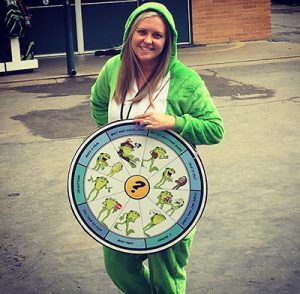Guest Post: Tattling vs. Telling
Students tattling is a common complaint of teachers across the nation, especially in the primary grades. Tattling is age-appropriate, as children have grown up having adults around to solve their problems and help guide resolution. Students in kindergarten, first, and even second grade may still see the “magic” in the way an adult can make a problem “disappear.” Luckily, 5-9 year olds are at a prime age for learning problem-solving skills. Developmentally, they are now able to differentiate between problems that they can handle, and those which warrant adult intervention. We just have to teach them how!
Each year, I have a few teachers come to me frazzled, hair amess, looking like Mrs. Frizzle from the Magic School Bus books.
“Help!!!” they beg me. “My students are constantly tattling, and I can’t take it anymore!”
About this time, I put my calming Zen waterfall YouTube videos on my computer screen and hand the teacher a calming jar. I might even offer chocolate.
This is my time to shine, and I jump at this opportunity! I offer to come in and teach some classroom guidance lessons, and teachers are ecstatic to have someone help with this problem. Depending on the grade-level and teacher buy-in, I may go into the classroom just one time, or for a series of lessons. It’s important to ensure that the teacher remains present in the room- this is not teacher break time! In order to keep the teacher engaged, I may use her as an example, ask her questions, or say things like, “When you go to Mrs. Smith with a tattle, she is going to ask you if this is a big problem or a small problem.”
 My lessons vary depending on the grade-level but in kindergarten, first grade, or second grade, they usually include a variety of resources. My district comprehensive counseling program has implemented Kelso’s Choice in all Kindergarten through 5th grade classrooms, so one of my first priorities is to be sure to bring my little green assistant- my Kelso puppet! Kelso’s Choice is an excellent program that fosters the development of conflict resolution skills beginning in kindergarten or Pre-K. Kelso teaches our little ones that “big problems” which are scary, unsafe, or illegal need help from an adult, while “small problems” can be solved independently. In a tattling vs. telling lesson, I begin by reviewing the basics of the Kelso’s Choice program, focusing on “big problems” versus “small problems.” Counselor tip: the more animated Kelso is, the more engaged the students will be! I use a frog voice when Kelso “talks” and the kids love it! I know I look absolutely ridiculous, but it makes the lessons go much more smoothly!
My lessons vary depending on the grade-level but in kindergarten, first grade, or second grade, they usually include a variety of resources. My district comprehensive counseling program has implemented Kelso’s Choice in all Kindergarten through 5th grade classrooms, so one of my first priorities is to be sure to bring my little green assistant- my Kelso puppet! Kelso’s Choice is an excellent program that fosters the development of conflict resolution skills beginning in kindergarten or Pre-K. Kelso teaches our little ones that “big problems” which are scary, unsafe, or illegal need help from an adult, while “small problems” can be solved independently. In a tattling vs. telling lesson, I begin by reviewing the basics of the Kelso’s Choice program, focusing on “big problems” versus “small problems.” Counselor tip: the more animated Kelso is, the more engaged the students will be! I use a frog voice when Kelso “talks” and the kids love it! I know I look absolutely ridiculous, but it makes the lessons go much more smoothly!
I find that a lot of my students get hung up on the idea of students being “mean.” They will raise their adorable tiny hands and say, “But Ms. Link, what about when someone makes a mean face at me?” Students feel that when someone is mean-spirited, they need to be corrected by an adult. They know that what the other person is doing is unkind and wrong, and they want to see it changed. Counselor tip: I almost never answer students’ questions regarding scenarios- I let their peers answer for me! I find it is much more powerful to hear advice or input from someone their age! As a group, we discuss how meanness feels like a big problem, but there are lots of things we can do to solve it in the moment. We look at the Kelso’s Choice wheel to determine which of the choices might work in this situation (walk away, ignore it, tell them to stop, talk it out, or wait and cool off). Our lesson then moves on to a “game” in which I give students some cards on which I have written scenarios and the student or group must decide if the subject should report the information to an adult or solve it himself. Counselor tip: in order to keep the students engaged, I bring lots of goodies or prizes to share (stickers, pencils, school supplies which have been donated, etc.). They love this! I leave the class with a small chart I found on Teachers Pay Teachers for free which shows the difference between tattling and telling. Counselor tip: make sure this, and anything else you’d like a teacher to use, is laminated so it will be hung in the classroom somewhere.
These types of lessons are easy to implement and often have big payoffs for the teacher. Even after I leave, teachers continue to reinforce the principles of the lessons and I get so many “thank you” emails from teachers after they see tattling subside. Sometimes they even give me chocolate!
Lauren Link, Lincrest Elementary School Counselor


